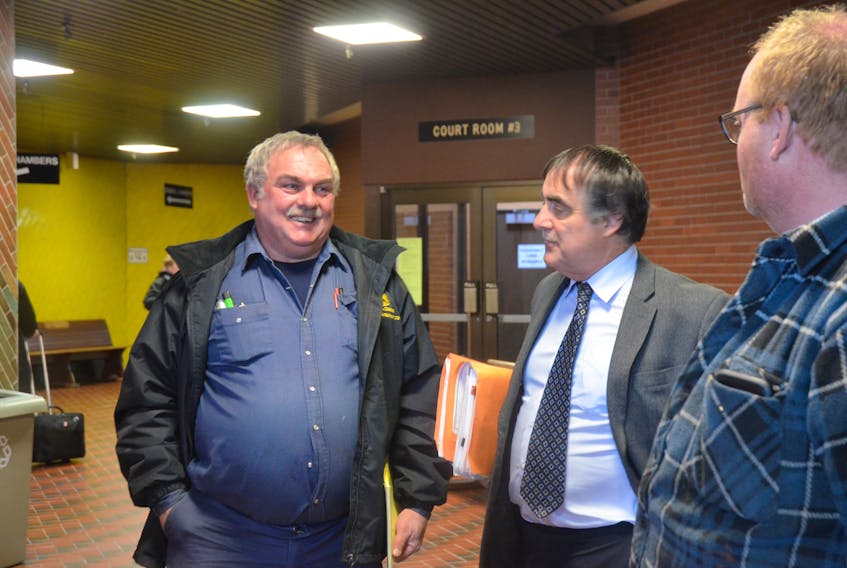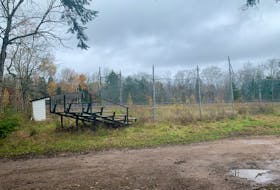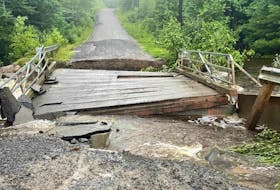KENTVILLE, NS - “I’m just glad that it’s over and now we can get on with things,” Derrick Shaffer said at the conclusion of his sentencing hearing.
Shaffer, the owner and operator of a waste transfer station and a construction and demolition (C&D) debris disposal site, was charged following a fire at his North River Road property in March 2016 that burned for several days.
In May 2017, Shaffer pleaded not guilty to all charges against Shaffer Enterprises, the C&D site, and 3144393 Nova Scotia Limited, the waste transfer station that he operates with his wife Barbara.
Shaffer, who has deferred further comment on the situation to a later date, changed his pleas to guilty on three charges in January and was sentenced on March 21. Two of the charges were against Shaffer Enterprises: being responsible for burning designated material without written authorization and contravening a term or condition of an approval. The third charge was against the numbered company, another count of contravening a term or condition of an approval.
READ ABOUT SHAFFER CHANGING HIS PLEAS TO GUILTY HERE.
Through defence lawyer Chris Manning, Shaffer requested to make a statement to the court prior to being handed his sentence.
Shaffer admitted to “doing some things wrong” at the site that weren’t in accordance with his approval and he asked for “equal and fair justice” with “everything that’s going on around the province.”
Judge Alan Tufts fined Shaffer $5,000 on the first charge, $18,000 on the second charge and $12,000 on the third, for a total of $35,000 in fines. $30,000 of the fines will be directed toward environmental funds for education or other initiatives. Maximum fines for the offences range from $500,000 to $1 million.
Shaffer has been given one year to pay the $5,000 fine; two years to pay the $12,000 fine and three years to pay the $18,000 fine.
Tufts granted a site assessment, monitoring and remediation plan as requested by Crown prosecutor Robert Morrison. Tufts did not order Shaffer to pay to have the details of the case published in the newspaper, citing “adequate media coverage.”
READ ABOUT THE SENTENCING RECOMMENDATIONS FROM THE CROWN AND DEFENCE HERE.
A fire at the North River Road property that is the location of both the transfer station and the disposal site broke out on March 22, 2016. The Kentville Fire Department declared the blaze extinguished on March 27, 2016.
The fire led to Environment Canada issuing an air quality warning for Kings County. Tufts pointed out that there was no evidence of any air quality testing or of anyone suffering from the smoke that resulted from the burning of so-called designated materials that weren’t permitted in disposal cells.

Tufts said Shaffer started dealing with the Department of Environment regarding issues the department had with his operation in November 2015. These discussions continued until the fire occurred.
“He believed that he had permission to conduct the operation as he was doing, which was not correct,” Tufts said. “To be fair, Mr. Shaffer does not offer this as a legal excuse. It appears to be a miscommunication or a lack of diligence or recklessness on his part.”
Tufts said it’s suspected that the cause of the fire was spontaneous combustion, which apparently is not an uncommon occurrence for these types of facilities. Shaffer had earlier testified to conflict between the fire department and Shaffer, who put his employees to work fighting the blaze. Tufts said Shaffer described challenges with the water supply and the necessity to build a road to access the fire.
“Mr. Shaffer became very emotional in describing his efforts around dealing with the fire. It obviously had a great impact on him,” Tufts said.
Shaffer had earlier testified that he was “$400,000 in the hole” as a result of the fire, including $100,000 that he spent fighting the blaze.
Tufts said Shaffer has accepted responsibility for the fire. It appears clear from the evidence that Shaffer was not sorting and separating materials effectively as they came into his facility. Some material that wasn’t permitted in the C&D cell was deposited on top of the cell, which Tufts said compounded the situation when the fire began.
Tufts said Shaffer allowed recyclable materials that he wasn’t supposed to keep for longer than 60 days to accumulate. Plastics and other materials that weren’t allowed in the cell hadn’t been sorted out, which presumably Shaffer “would have gotten around to doing.”
Tufts said Shaffer’s dialogue with the Department of Environment wasn’t focused and he had been discussing the situation with them for months before the fire. Tufts said there was a communication gap and a lack of urgency to deal with the variances that were identified.
Tufts said he would characterize Shaffer’s conduct as “negligent” or “reckless” but he was not “defiant” in violating his approval. Shaffer was trying to reuse and recycle items, which Tufts said was admirable, but the accumulation of materials overwhelmed the situation.
Tufts said fines are often linked to the economics of an offending operation but he didn’t hear any evidence on the economic size and sophistication of the subject business. This would be an important part of his analysis. Tufts said fines couldn’t amount to a “license fee” for committing an offence.
Tufts said it isn’t clear how much plastic, rubber and other designated material was present in the cell that caught fire. He accepted Shaffer’s testimony that there weren’t tires in the cell. There were asphalt shingles, which were allowed in the cell but were not permitted to be burned.
He said Shaffer’s failure to cap the cells adequately increased the risk of a fire and made it more difficult to fight the fire. Capping of cells was not done as prescribed with clay but instead wood chips and gravel were used.
There was no effective emergency plan, roads and ponds were not configured as indicated in the site approval and Shaffer had failed to construct storage sheds. Shaffer didn’t have adequate monitoring wells.
Tufts said there was no evidence that the soil or groundwater contain leachate coming from items at the site. Testing was ordered by the Department of Environment and conducted by Shaffer but it was inadequate. Tufts said he isn’t sure why the department didn’t take it upon itself to have the testing done to an adequate level to give a clear indication if the environment had been compromised.
Tufts said high levels of arsenic and lead have been detected but couldn’t be attributed to Shaffer’s operation. Tufts said he could speculate on what caused this but it wouldn’t be appropriate for him to do so.









